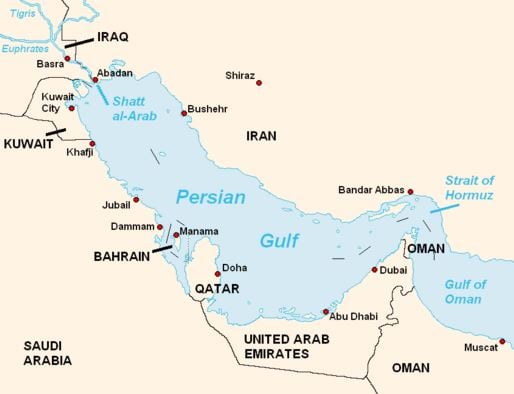Persian Gulf heat may become so intense due to climate change that much of the region could become inhospitable for human life, say two scientists from Loyola Marymount University, Los Angeles, and the Massachusetts Institute of Technology (MIT).
Conditions are likely to become too hot by the end of this century, Prof. Elfatih Eltahir and Dr. Jeremy Pal wrote in the academic journal Nature Climate Change, after conducting a study of high-resolution climate models.
This devastating news is relevant to many parts of the Persian Gulf if nothing is done about greenhouse gas emissions, the authors warn. However, if we start doing something about it now, there is still a chance the region could be saved, they emphasize.
 The Persian Gulf region includes Iran, Kuwait, Bahrain, Iraq, Oman, Qatar, Saudi Arabia and the United Arab Emirates. (Image: Wikipedia)
The Persian Gulf region includes Iran, Kuwait, Bahrain, Iraq, Oman, Qatar, Saudi Arabia and the United Arab Emirates. (Image: Wikipedia)
Given the region’s intense sun and shallow waters, the Persian Gulf is “a specific regional hotspot where climate change, in absence of significant mitigation, is likely to severely impact human habitability in the future,” the authors wrote.
It’ll be too hot even in the shade
Prof. Eltahir and Dr. Pal ran high-resolution versions of standard climate models and found that dozens of major cities in the Persian Gulf would become far too hot for humans to live in, even in shaded and well-ventilated spaces.
This threshold “has never been reported for any location on Earth,” said Prof. Eltahir.
The point at which the environment becomes inhospitable involes the ‘wet-bulb temperature’ – a measurement that combines both temperature and humidity – which reflects conditions in which our bodies could continue functioning properly without artificially lowering the ambient temperature.
For a human being to have a good chance of surviving for more than six unprotected hours, the temperature must not be higher than 35 Celsius (95 Fahrenheit), the authors showed. This is the equivalent ‘heat index’ (according to the National Weather Service) of approximately 165 °F.
Already very close to the threshold
During a heat wave that lasted a week in the Persian Gulf this year, this limit was nearly reached. In Bandahr Mashrahr (Pop: 154,000), the capital of Mahshahr County, Khuzestan Province, Iran, the wet-bulb temperature threshold was almost reached for approximately one hour.
 When the region gets too hot for humans to live in, where will they go?
When the region gets too hot for humans to live in, where will they go?
If these temperatures persist for several hours, there is a serious and dangerous risk to human health, the authors write.
Why is the Persian Gulf so hot?
The Persian Gulf is probably the most vulnerable region on Earth to extremely high temperatures. This is due to a combination of a very shallow sea, low elevations, clear skies, and a water body that raises heat absorption.
When you combine all these factors, you get very high water temperature, which in turn leads to strong evaporation and extremely high levels of humidity.
Over a period of thirty years, Dubai, Abu Dhabi, Doha, Bandas Abbas and several other cities in the Persian Gulf may exceed the wet-bulb temperature threshold.
Prof. Eltahir adds that the extremely hot summer conditions that occur today about once every twenty days will be average summer days in the future.
In other parts of the Middle East, where less extreme heat is forecast, such as next to the Red Sea on the other side of the Arabian Peninsula, predictions show that wet-bulb temperatures will probably range from 32 °C to 34°C – temperatures which are also considered potentially dangerous for human health.
There are events in the region when huge numbers of people gather from all over the world and stand around in the sun for hours. The annual Islamic pilgrimage to Mecca – the Hajj – sometimes falls during these extremely hot months. The Hajj attracts more than 2 million pilgrims each year.
Perhaps some of the wealthier countries in the area may find ways to adapt to the extreme heat, but poorer nations, such as Yemen, will not, the authors warn.
Reference: “Future temperature in southwest Asia projected to exceed a threshold for human adaptability,” Elfatih A. B. Eltahir and Jeremy S. Pal. Nature Climate Change. 26 October, 2015. DOI: 10.1038/nclimate2833.
Video – Persian Gulf and Climate Change

